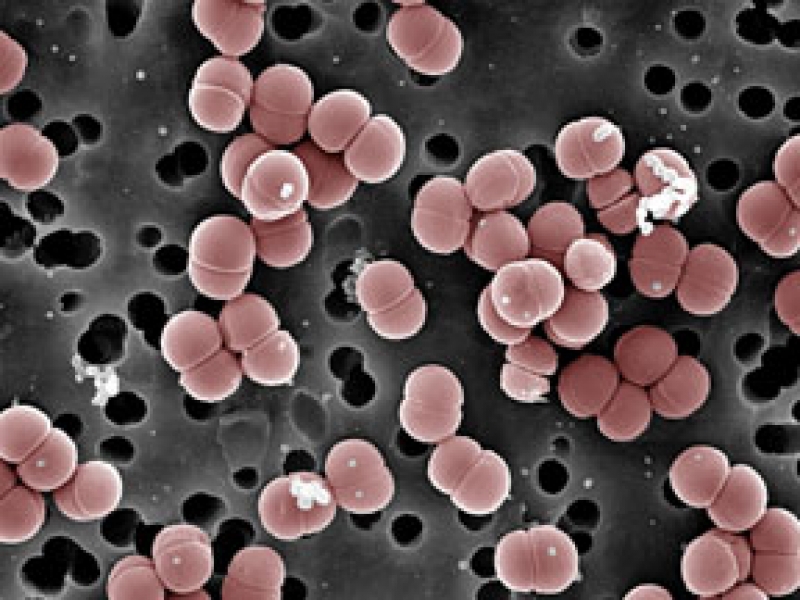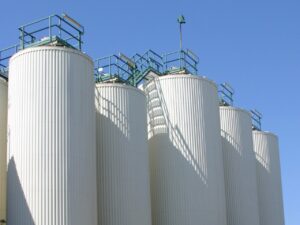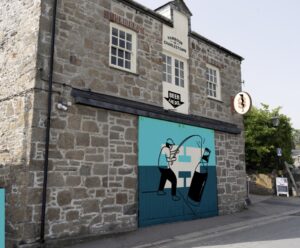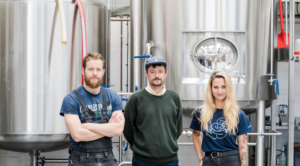Pediococcus are homo–fermentive, in which they utilize glucose to produce lactic acid (using the Embden-Meyerhof-Parnas pathway). However metabolic end products vary according to the conditions provided, typically beer spoilage Pediococcus produce diacetyl as a major byproduct.
The genus Pediococcus consists of the following species: P. acidilactici, P. pentosaceus, P. damnosus, P. parvulus, P. inopinatus, P. halophilus, P. dextrinicus, and P. urinaeequi. Of which P. damnosus is considered the major beer spoiler.
Pediococcus as with some other LAB have been used as probiotics for many years both as food preservers such as in sauerkraut, kefir, khadi, soy, and dry sausage, as well as a pre-culture and flavour enhancer in some cheeses and yoghurts. Off flavour properties which include the production of a butter and butterscotch is actually used to enhance the flavour of some beverages e.g wine (esp chardonnay) and cider. Pediococcus is also a major component of a lambic beer culture and can be bought either as a sole inoculant or in a sour beer inoculation mixture along with Lactobacillus.
In addition to their acid producing properties LAB also produce antibacterial proteins known as bacteriocins which have been found along with pH to act as affective preservatives, and since the safety of chemical preservatives have been questioned the use of LAB and their metabolites is generally accepted by consumers as something natural and healthy. As such fermented foods are currently seeing a resurgence in popularity.
There are about 20 gram positive lactic acid producing bacteria that have been identified as beer spoilers, of these Lactobacillius brevis is the most common, however Pediococcus species and especially P. damnosus are also a major issue, even more so as its presence in spoiled beer been under reported.
Pedioccocus damnosus was originally named Pediococcus cerevisiae, this was later changed to damnosus, by Claussen in the early 1900’s. A further species of Pedioccocus called claussenii has recently been described as a new beer spoiler as has Pediococcus inopinatus.
Approx 60-90% of beer spoilage incidents are linked to LAB, among the most prevalent of these is Pediococcus damnosus, which between 1992-2002 accounted for anywhere between 3-31% of spoilage incidents per year. It must be noted however that Pediococcus species can be hard to cultivate using traditional microbiological media and either media that has been optimised for Pediococcus or the use of DNA technology is now being used to improve detection rates.
Beer Spoilage by P. damnosus is often characterised by diacetyl formation along with lactic acid production, the amount of diacetyl is often very high and detectable even at low bacterial levels. Because of its ability to grow even at low temperatures spoilage can occur in the fermentation and maturation stage of beer production as well as in bottled products. Pediococcus contamination is also a problem in pitching yeast, as the bacteria is thought to bind to the yeast cell and is difficult to remove.
Some Pediococcus bacteria are now so specialised as a beer spoiler that some forms cannot live outside of the brewery.
Direction
Pediococcus are difficult to detect using traditional culture methods and often require specialised media, because of its propensity to grow at low temperatures the optimum culture temperature is 22-25, unfortunately Pediococcus can in fact often fail to grow even on specialised media including de Man, Rogosa and Sharpe (MRS) as well as Raka-Ray media, the media often recommended for beer spoilage LAB. Therefore new types of liquid culture media are now being widely used. This type of chromogenic media (colour changing) relies on the ability of the bacteria to produce lactic acid which turns the media from one colour into another, making detection easier and often quicker (FastOrange), than waiting for the bacteria to form visible colonies.
Other LAB detection methods include the detection of gas produced by the bacteria (SpeedyBreedy) and probably the gold standard, the detection of Pediococcus DNA and/or the beer spoilage genes themselves that are only found in spoilage LAB (BrewTek).
Highly specialised bacteria such as those found in the brewery are now known to be very fastidious and exhibit hard to cultivate characteristics, it is therefore suggested that incident reporting has been underestimated and in fact P. damnosis could be far more prevalent than current data suggests.
Similar to other beer spoilage LAB, Pediococcus are are perfectly adapted to the brewing environment, there is some evidence that certain elements in the brewing process actually promote the growth of these bacteria. In some cases the bacteria have lost the ability to utilize a wide range of sugars and rely on the brewery almost as their sole environmental niche.
Several factors appear to be critical for the inhibition of Pediococcus is beer samples, of these pH and Hop Acids are amongst the most well known, low pH promotes the antibacterial affects of hop acids, however it has also been found that a tiny increase in pH (0.2) can reduce the efficacy of hops acids by as much as 50% and therefore closely monitoring pH can aid in the reduction of beer spoilage opportunities.
Carbon Dioxide levels are also critical in the reduction of Pediococcus infections, beer with low levels of CO2 have been found to particularly susceptible to spoilage, e.g. cask or Nitrogen gassed ales. However the usual rapid use of this type of product may mean that the product is used before an infection becomes obvious.
Hop Resistance
Because beer spoilage bacteria can be hard to culture and the fact that beer spoilage can often be caused by a mixed population bacteria, often only those bacteria that are easier to grow that are identified. In addition to this some bacteria that will grow on media may not actually be beer spoilers and the brewer must rely on the experience and judgment of the microbiologist to tell them if the bacteria grown will produce off flavours.
Because of this there maybe some over reporting of spoilage attributed to one or two types of bacteria and under reporting of others.
However the discovery of ‘hop spoilage’ genes carried almost exclusively by beer spoilage LAB has meant that even if the type of beer spoilage LAB is not known the brewer will at least know if the bacteria found is a spoiler or not. The advent of DNA technology now means that those species carrying the genetic markers of spoilage can be quickly and accurately identified even if they have not yet been described in the literature.
Those genes, termed horA and horC, give protection against the antibacterial affects of hop acids, and are therefore critical in the bacteria survival, however their role in spoilage may be wider than is generally accepted and these genes may also enable bacteria to survive in high alcohol environments.
Because of this, spoilage gene detection technology such as that being used by Pura Diagnostics means that beer spoilage bacteria can be quickly identified, results can often be ready in 48 hours which is several days ahead of even the best culture methods.
There are a fair few theories to how hop resistance came about, and depending on what level you want to go to, it can either be quite logical or a little mind blowing. In essence the environmental pressure, of existence in the brewery forced the bacteria that could gain a foothold via their presence in raw materials used in beer to adapt and survive in the brewery.
Breweries are full of sugar, protein and carbohydrate, as well as vitamins and minerals. They are also wet and warm, an ideal habitat for a bacterium. However in amongst this there is the anti-bacterial hop acids, alcohol and low pH to deal with. Therefore bacteria have in a relatively short evolutionary time period (a few 100 years) opted to develop resistance and maintain it in the form of hop resistant genes.
This process is energy intensive, however as there is a plentiful supply of sugar available this isn’t an issue at the outset. Yet as soon as you take the LAB away from the selective pressure of the brewery the bacteria begin to loose the genes. So this is a case of the bacteria cutting its cloth.
Now to go a little deeper you have to accept that in the dim and distant past, cells and genes lived separate lives. Single celled organisms at the time (primordial soup period) were the highest life form, and possibly preyed on genes and other free-living entities, that are now incorporated into cells.
There was probably a period where the cell and the gene fought it out for dominance until eventually they entered an equilibrium, the hardy bacteria protected the delicate gene, gave it a place to stay, food and mobility as well as a low energy means of replication via entry into other bacteria, and the gene gave the bacteria novel proteins that enable it to quickly overcome environmental hurdles.
This hasn’t just happened with genes, the organelles our cells use to produce energy, the mitochondria are a classic example, at some point these organelles lived as separate creatures. The mitochondria have their own DNA and are easily recognizable within the cell, they take the glucose we eat and making energy via respiration. They get a safe place to live, they replicate independently and we get the energy to preserve life (a fair deal).
Anyway I digress, the point is that the gene and bacteria were separate living things that saw the possibility of a successful partnership, this deal was so successful that now genes are no longer capable of living without bacteria, and visa versa. So important are these genes that when one type of bacteria meets another type they can often swap genes, which is one way that antibiotic resistance genes can be passed onto different bacterial species.









